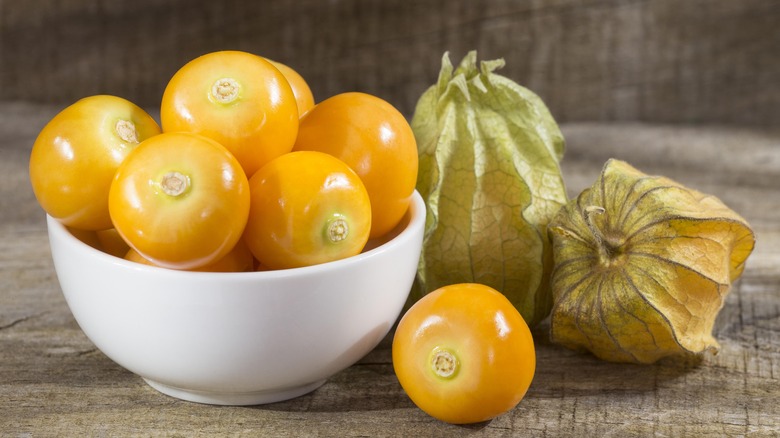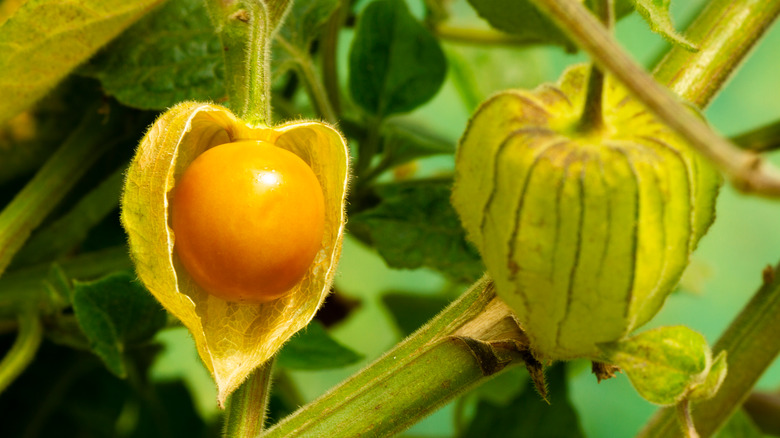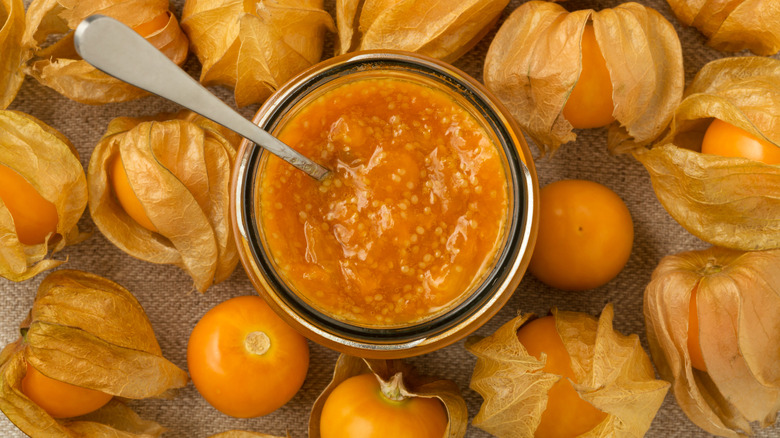Golden Berries: The Little-Known Superfood That Tastes Like Clementines And Cranberries
Every now and then, there's a particular food that society suddenly elevates to a higher status. In the past, some of these have included salmon, avocados, kale, and blueberries — all put in the limelight for being superfoods. (For the uninitiated, what we call "superfoods" are essentially types of food "that offer maximum nutritional benefits for minimal calories," according to Medical News Today.)
It seems like the superfood craze has been everywhere lately. On TikTok, users constantly showcase new superfood discoveries, praising their ingredients and nutritional values. However, the concept of "superfood" dates back to the 20th century, according to the Harvard T.H. Chan School of Public Health. One of the biggest examples of this was a 1928 pamphlet published by the United Fruit Company, now known as Chiquita, which marketed bananas as a superfood, touting the fruit as an affordable, digestible source of nutrients.
Even so, according to Northwestern Medicine, there is actually little scientific evidence backing the nutritional claims about superfoods. That's not stopping people from gravitating toward products claiming to be superfoods, though. As recently as 2015, there was a 36% increase in products labeled as superfoods (via Mintel Press Office). Now, the latest superfood on the scene has been all over TikTok, with Refinery29 calling it "raisins and dried cranberries' hip younger sister."
What are golden berries?
Golden berries, cape gooseberries, Peruvian ground cherries, or Inca berries. Whatever you call the yellow-golden fruit, they have been drawing the attention of American consumers (via Fruit Growers News). According to Nourish by WebMD, golden berries originated in parts of Peru, Chile, and the Andes Mountains, and were first cultivated by the Incas approximately 4,000 years ago. In addition to its compact size — they're about the size of cherry tomatoes — and color, golden berries are known to be tart and tangy, like pineapples and mangoes (via Healthline). Others say the berries taste like a combo of clementines and cranberries (via Eat This, Not That!).
Golden berries have been lauded as a superfood and for its nutritional value. The fruit is packed with carotenoids, which are antioxidants that can prevent cell damage and improve your cardiovascular system, per Nourish by WebMD. Registered dietitian nutritionist Mascha Davis tells Refinery29 golden berries are a source of vitamins and fiber; the fruit has high vitamin C and A content and contains low amounts of sugar.
How to eat golden berries
Fresh and dried golden berries can be found in several grocery stories, including Whole Foods and Trader Joe's. While you can eat the berry whole, its tough texture may put off certain people, per Refinery29. However, golden berries can be incorporated into nearly any recipe. You can blend golden berries into a smoothie or turn them into jam (via Healthline). If you have dried golden berries, they can be used as toppings for oatmeals and baked into granola bars, Mascha Davis notes to Refinery29.
Many chefs praise golden berries' ability to pair well with sweet and savory flavors. Kyle Knall, the executive chef of Electric Lemon, enjoys golden berries in summer salads "paired with corn or a grilled item" (via Food & Wine). It can add tartness to salsa or ice cream as a topping, and even be incorporated into a sorbet, which restaurant Addison's chef William Bradley combines with melon and ginger. With the versatility that comes with golden berries, it's no wonder the fruit is gaining the attention of foodies everywhere.


